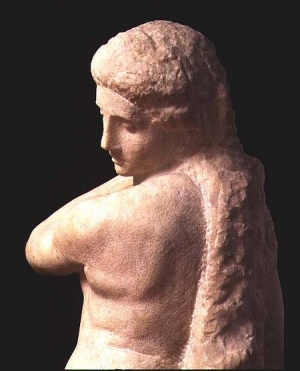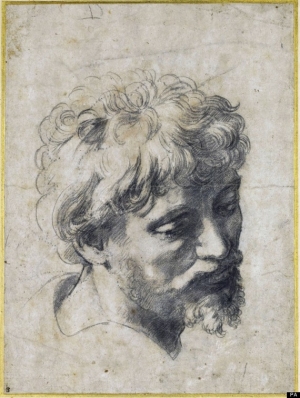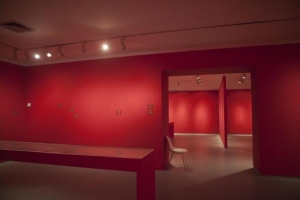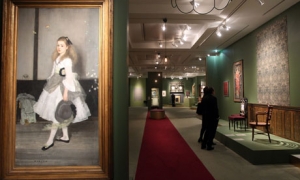|
Displaying items by tag: renaissance

As part of a yearlong celebration of Italian culture hosted by Italy’s foreign minister, Michelangelo’s (1475-1564) iconic work, David-Apollo, will be go on view today at the National Gallery of Art in Washington, D.C. Minister Giulio Terzi di Sant’Agata unveiled the sculpture yesterday, December 12. David-Apollo will be on view in the West Building’s Italian galleries through March 3, 2013.
Michelangelo carved David-Apollo in 1530 for Baccio Valori, who served as the interim governor of Florence per the Medici pope Clement VII’s appointment. Michelangelo and the pope were at political odds, but the artist wished to make peace with the Medici through his work. Michelangelo never finished David-Apollo as he left Italy and never returned after Clement VII’s death.
Part of the Museo Nazionale del Barello’s collection in Florence, David-Apollo traveled to the National Gallery once before in 1949. The masterpiece’s installation in Washington over sixty years ago coincided with former president Harry Truman’s inaugural reception and attracted more than 791,000 visitors. In 2013, David-Apollo’s presentation will coincide with President Barack Obama’s inauguration.
The Year of Italian Culture, launched by Sant’Agata under the auspices of the President of the Italian Republic, Giorgio Napolitano, will bring a range of Italian masterpieces to nearly 70 cultural institutions across the United States. Works range from classical and Renaissance to baroque and contemporary and cover the realms of art, music, theater, cinema, literature, science, design, fashion, and cuisine.

At Sotheby’s London’s Evening Sale of Old Master & British Paintings on December 5, a rare drawing by Raphael set a new record for the artist at auction. A masterpiece in black chalk, Head of a Young Apostle (circa 1519-20), has been part of the Devonshire Collection at Chatsworth since 1720 and features one of the key figures in the artist’s final work, Transfiguration, a celebrated painting from the Renaissance, which is now in Rome’s Vatican Museum.
Amid a considerable amount of bidding both in the auction room and on the telephone, Head of a Young Apostle sold for $47.8 million, nearly three times the drawing’s low estimate of $16 million to $24 million. Gregory Rubenstein, Worldwide Head of Old Master Drawings at Sotheby’s, said, “A number of the world’s greatest collectors stepped up tonight in recognition of the genius of Raphael and the extraordinary beauty of this drawing.”
The sale proves that the market is still prime for Old Master works. Head of a Young Apostle is one of three exceptional Raphael drawings to appear at auction in the past 50 years; each work has set an all-time sale record for an Old Master drawing. This particular sale is the highest price paid at a European auction in 2012 and is the second highest Old Master sale to date. The first is Peter Paul Rubens’ Massacre of the Innocents, which sold for $76.7 million at Sotheby’s in 2002.
Sotheby’s Old Master sale realized almost $94 million and sold 74.5% by lot.

While rocket fire is a normal occurrence in southern Israel, the recent attacks on Tel Aviv, the country’s northern capital city, has art museums in the area taking extra precautions. The walls of the Tel Aviv Museum of Art have been stripped and nearly 200 works, including approximately 100 works by relatives of the Renaissance master Pieter Brueghel the Elder, were moved to a rocket-proof safe late last week.
While the Israeli-Palestinian conflict has continued to escalate, other museums are following suit. The curator of the Ashdod Art Museum in southern Israel has taken down 15 works by the leading Contemporary Israeli artist, Tsibi Geva, and placed them in a vault deep underground. The structure is designed to withstand both rocket fire and biological weapons. It was the first time the Ashdod Museum has taken down any art amid attacks since opening in 2003.
While air strikes are creeping up from the southern Israel’s traditional rocket range to Jerusalem and Tel Aviv, some institutions are holding out on stashing their works. The Eretz Israel Museum in Tel Aviv, which specializes in Near Eastern antiquities and other art, has left its treasures in place. The Israel Museum in Jerusalem, which houses some of the country’s most prized antiquities and cultural artifacts has also continued to operate as usual.
The last time the Tel Aviv Museum of Art took down works during a conflict was in 1991 when Iraqi scud missiles pounded the city during the Gulf War.

The grandeur hits you as soon as you walk in. On the austere, slate-grey wall of the Musée d'Orsay's newly renovated impressionist gallery, Manet's Déjeuner sur l'Herbe stops visitors in their tracks.
The plump female nude at the heart of the canvas, who so scandalised 19th-century opinion in the Paris Salon, is recognisable, but there is something splendidly different about its new presentation.
After Manet, there are the other crown jewels of impressionism: the Degas ballerinas, Monet's poppies, Renoir's Moulin Rouge dancers, Cézanne's card players, and dozens more of the world's best-known 19th-century French masterpieces. The colours leap out from the long, sombre walls.
The museum's president, Guy Cogéval, had spoken before its reopening of a "renaissance" of the Musée d'Orsay and its world-renowned collection, and promised to show the impressionists as we had never seen them before. The expert judgment, ahead of the public opening of the new-look museum on 20 October, is that he has been true to his word.
It has taken almost €8m (£7m) to create this new gallery – part of a two-year renovation of the museum costing €20m – in which clever use of colour and illumination shows the works in an entirely new light.
Gone are the cramped corridors, the dead ends, the white stone walls and floors and the glaring light from the massive glass canopy that forms a central avenue over the top-floor gallery in the Pavillon Amont, the west wing of the building.
The new, subdued walls and floors, along with artificial lighting, have created what Cogéval describes as an "intimate", almost homely, atmosphere in a gallery that he says is the "beating heart of the museum".
"These paintings were, after all, intended to be hung on walls in homes, not in a museum," he says.
With his gelled hair, slightly rumpled suit and unbridled enthusiasm, Cogéval, 55, an art historian who took over as president of the Musée d'Orsay in January 2008, has the appearance and air of an over-excited schoolboy. "Everyone said I couldn't touch the museum when I arrived because it is a historic building and all that. But I have proved them wrong. I said we would do this, and we did," he says, with undisguised glee. "The whole space has been transformed. It's magnifique!"
The 19th-century painters, working in an era before the electric light bulb became widespread, would doubtless have appreciated the modern tricks of artificial light employed to show their work to extraordinary effect.
Developing artistic and scientific techniques to capture on canvas the way that light transformed landscapes and objects became an obsession among the impressionists. The focus was crucial to creating what they termed "optical realism".
Claude Monet said of impressionism, the movement he founded and led: "Light is the principal person in the picture." To that end, he strove over and over again to encapsulate the way that light danced over the Thames at Westminster, the cathedral at Rouen, the water lilies on the pond at his home in Giverny, and the nearby haystacks – all at different times and in different weathers.
Curator Xavier Rey, one of the team hanging the impressionist works in the new fifth-floor gallery, said that before the renovations the paintings had been lit solely by sunlight. "The new system of lighting has transformed everything. Now we have a combination of halogen and new-generation diode lights that reproduce the richness of sunlight, but directly light the paintings and reflect the colours and details. It really does mean the works are being seen in a new light, which was our intention."
He added: "Hanging the works on coloured walls is also closer to the way the impressionist paintings would have been displayed in their time."
As for the impressionists, the devil was in the detail and colour; Parisian architect Jean-Michel Wilmotte said his team had experimented with various shades of grey before coming up with the right one.
|
|
|
|
|